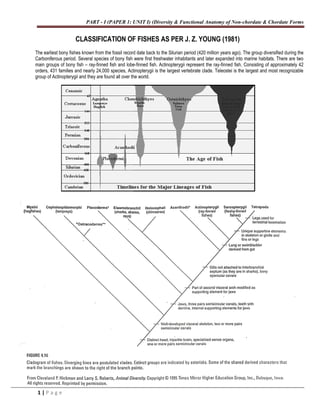
CLASSIFICATION OF FISHES in details all describe
- 1. PART - I (PAPER 1: UNIT I) (Diversity & Functional Anatomy of Non-chordate & Chordate Forms 1 | P a g e CLASSIFICATION OF FISHES AS PER J. Z. YOUNG (1981) The earliest bony fishes known from the fossil record date back to the Silurian period (420 million years ago). The group diversified during the Carboniferous period. Several species of bony fish were first freshwater inhabitants and later expanded into marine habitats. There are two main groups of bony fish – ray-finned fish and lobe-finned fish. Actinopterygii represent the ray-finned fish. Consisting of approximately 42 orders, 431 families and nearly 24,000 species, Actinopterygii is the largest vertebrate clade. Teleostei is the largest and most recognizable group of Actinopterygii and they are found all over the world.
- 2. PART - I (PAPER 1: UNIT I) (Diversity & Functional Anatomy of Non-chordate & Chordate Forms 2 | P a g e TAXON NAMES AND FEATURES ORIGIN EXAMPLES Class: PLACODERMI 1. Heavily armoured body with sharp spines. 2. Bottom living, dorso-ventrally flattened body reassembling modern rays. 3. Lived in both seas and fresh water. 4. Bony head-shield movably joined with trunk-shield. 5. Tail heterocercal. 6. Lateral line canals run in grooves inside bony outer layer. 7. Jaws devised with bony plates with sharp edges but usually no teeth. 8. Paired pectoral and pelvic fins Lower - Upper Devonian* Class: CHONDRICHTHYES Middle Devonian - Recent Subclass 1: ELASMOBRANCHII Previously it was mistaken that elasmobranches are earliest and less evolved fishes. Evidences suggest sharks, skates and rays are highly advanced creatures and are hugely successful as aquatic predator irrespective to that they lack a bony skeleton. 1. Tail heterocercal. 2. Clavicle present. 3. Males possess paired claspers near anal fin. 4. Swim bladder absent. 5. Mouth ventrally placed. 6. Microscopic placoid scales all over the body. 7. Body skeleton cartilaginous. Devonian - Recent Subclass 2: BRADYDONTI / HOLOCEPHALI 1. Holostylic jaw suspension. Upper jaw is firmly fused with skull. Devonian - Recent Chimera sharks Class: OSTEICHTHYES Subclass 1: ACANTHODII 1. Jaws formed by palatoquadrate and Meckel’s cartilage. 2. Caudal fin epicercal or heterocercal. 3. Terminal mouth small nasal capsules mostly were mid- and surface- water feeders. 4. Found in both freshwater and marine environments Ordovician – Permian* Acanthodes sp. *Extinct Subclass 2: ACTINOPTERYGII 1. Actinopterygians were characterized by a single dorsal fin. 2. Paired fins were provided with basal support which projects out of body wall 3. Many have developed spines used as defense against predators that derived from the rays that make up the fins. 4. Ray-finned fish have homocercal tails. 5. Number of bones reduced in the skull. 6. Swim bladders also assist with movement, specifically buoyancy and are believed to have functioned as a primitive lung in early actinopterygians. 7. Ancestral actinopterygians usually had very hard, thick ganoid scales for protection. However, modern ray-finned fish usually have lighter more flexible scales known as ctenoid or cycloid scales. Infraclass 1: CHONDROSTEI Order: PALEONISCOIDEI Devonian - Recent Polypterus sp.
- 3. PART - I (PAPER 1: UNIT I) (Diversity & Functional Anatomy of Non-chordate & Chordate Forms 3 | P a g e Order: ACIPENSEROIDEI Jurassic - Recent Acipenser sp. Polypodon sp. Infraclass 2: HOLOSTEI Triassic - Recent Bowfin (Amia sp.), Gar-pike (Lepisosteus sp.) Infraclass 3: TELEOSTEI 1. Spiracle completely absent. 2. Scales lacks ganoid layers. 3. Maxilla is greatly reduced. 4. Clavicle absent. 5. Endoskeleton fully ossified. 6. Swim bladder is a hydrostatic organ present in all members. 7. Gills are holobranch and filamentous, enclosed by operculum on either side. 8. Conus arteriosus is greatly reduced. Upper Triassic - Recent Superorder 1: ELOPOMORPHA Cretaceous - Recent Eel (Anguilla sp.) Superorder 2: OSTEOGLOSSOMORPHA Jurassic - Recent Butterfly fish (Pantodon sp.) Superorder 3: CLUPEOMORPHA Cretaceous - Recent Herring (Clupea sp.) Superorder 4: OSTERIOPHYSI Eocene - Recent Carp (Cyprinus sp.), Catfish (Silurus sp.) Superorder 5: PROTOACANTHOTERIGII Upper Cretaceous - Recent Trout (Salmo sp.) Superorder 6: PARACANTHOTERIGII Eocene - Recent Angler fish (Lophius sp.) Superorder 7: ATHERINOMORPHA Upper Cretaceous - Recent Flying fish (Exoceoetus sp.) Superorder 8: ACANTHOPTERIGII Upper Cretaceous - Recent Pipefish (Synagnathus sp.), Seahorse (Hippocampus sp.) Basis of Classification Classification of organisms always based on some morphological or physiological features which play crucial role in evolution of major groups in animal kingdom. Fishes or icthyofauna were classified on the basis of the occurrence of following features. 1. Endoskeletal configuration – whether bony or cartilaginous endoskeleton and 2. Exoskeletal structures - Presence or absence of bony plates. Scale types (ganoid, cosmoid, placoid ctenoid or cycloid) 3. Pattern of paired fin 4. Fin supports - Presence or absence of basal support to the fins 5. Tail or caudal fin type – homo, diphy or heterocercal. 6. Fin-rays Salient features Endoskeleton, Scale types, fin-rays, gill types, swim bladder, caudal fin, mouth placement spiracle or spiral valves in intestine etc.
- 4. PART - I (PAPER 1: UNIT I) (Diversity & Functional Anatomy of Non-chordate & Chordate Forms 4 | P a g e